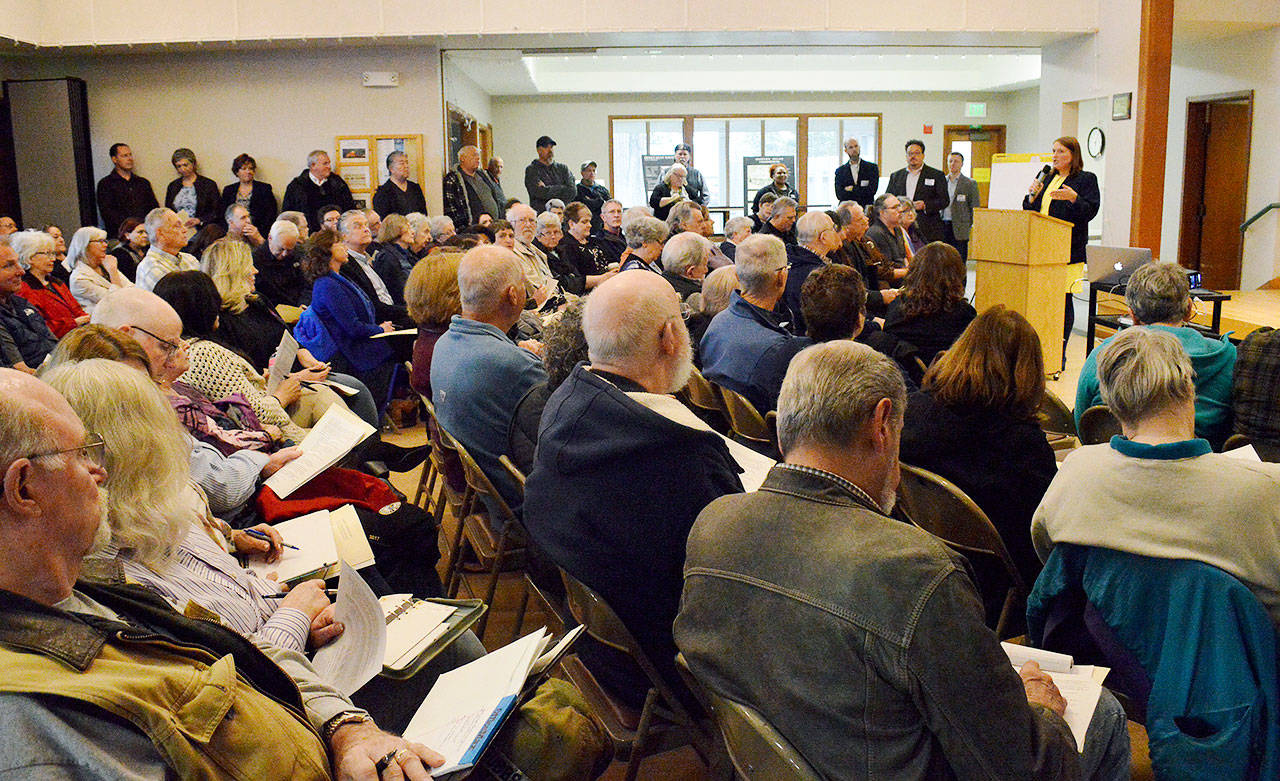Emotions ran high Thursday night at a packed meeting about an affordable housing project planned for Pioneer Way in downtown Oak Harbor. Around 150 people filled the Oak Harbor Senior Center to hear about the proposal from the Low Income Housing Institute (LIHI), a non-proft group that develops, owns and operates housing for low-income, homeless and formerly homeless people in the state.
Oak Harbor Mayor Bob Severns and Island County Commissioner Jill Johnson held the meeting to provide information about the project and allow for public comment. Those in attendance voiced strong opinions both in favor and against the project.
“We wanted the community to have an opportunity to talk because we value your input and your thoughts,” Johnson said at the meeting. “It’s important to both of us, but the other part to keep in mind is that this is a private transaction. If this property complies with the zoning laws, they can build it.”
The project is a 51-unit affordable housing complex that would be located near Hal Ramaley Park and will likely have retail space and a public plaza on the ground level, according to Robin Amadon, LIHI development director. Half the units would be for individuals who make 50 percent of the area median income and the other half would be for those who make 30 percent of area median income or below. The area median income is $77,300 per household in Island County,
At least 20 of the units would be reserved for qualifying veterans. The 51st apartment would be either for a live-in property manager or maintenance supervisor, Amadon said.
The Opportunity Council would provide on-site services for the veteran residents that would include connecting them to resources and treatment, determining qualification for veterans benefits and assisting with issues that may be impacting stable housing, according to Lisa Clark of Island County Opportunity Council.
“We expect that there’s a very great need for veterans experiencing homelessness or at dire risk of experiencing homelessness,” Amadon said at the meeting.
The view of the water was a factor in choosing the property, Amadon said, for its calming and beneficial effect on the future veteran residents in particular. However, the project’s location was a main point of contention for many in the audience Thursday night. People began shouting out comments and questions after the main presentation was completed.
“This is a wonderful idea, a wonderful project,” said one woman during the question-and-answer portion. “I just think it’s the wrong location.”
She and others expressed concern that the development would take away from potential businesses opening downtown.
“We’re working extremely hard down there to turn our downtown around,” said Dan Evans from the Oak Harbor Main Street Association. “We know it has its struggles. We know it’s had its problems, but the thing that we also know is that if we can have businesses downtown, we’ll have more jobs available for people to make more money.”
Amadon and Joanne Pelant, county housing coordinator, both said that it’s likely the residents would benefit the city’s economy because they would have more disposable income with lower rent. Pelant said her experience working with individuals struggling with housing has shown that once they are in stable living situations, they have more time to devote to things like getting another job or taking classes, which can increase their income.
Amadon also pointed out that people served by this type of housing often don’t own cars, so they are likely to do their shopping locally and within walking distance. She also said the proposed design might serve the downtown area well.
“I hope that in hearing the 50 percent workforce households that it serves and provides units for, as well as the design —- the public plaza, the linkage to the waterfront —- you might’ve heard some public benefits that Oak Harbor and Island County might derive,” Amadon said.
There is also a question as to whether the zoning in the area would allow for residential units. Amadon said because the project is still in a preliminary phase and the organization hasn’t completed a pre-application with the city’s planning department. Although she said there were some possible solutions, the zoning answer is “yet to be determined.”
Some of those present expressed dismay that the development would be exempt from property taxes and that LIHI will use some state grant funding to build it. One man suggested the four-story design wouldn’t be suitable for a small town and that maybe the project itself wasn’t suited for a small town.
As the crowd became heated, Johnson appeared more frustrated and disheartened.
“I was really hopeful,” she said toward the end of the meeting with tears in her eyes. “When you saw who would be served by this —- people who work at banks, people who bag our groceries —- we could get beyond the stereotype of folks who are downtown right now and think about what this would mean for our workforce.”
Others said they worried the development would draw low-income and homeless people from outside the county. Johnson said she understood this fear and she had it too when she first heard about the project.
“I understand what you’re scared about,” she said. “I just need a little bit more thought about who we are as a community, because these are our community members. They do live here.”



